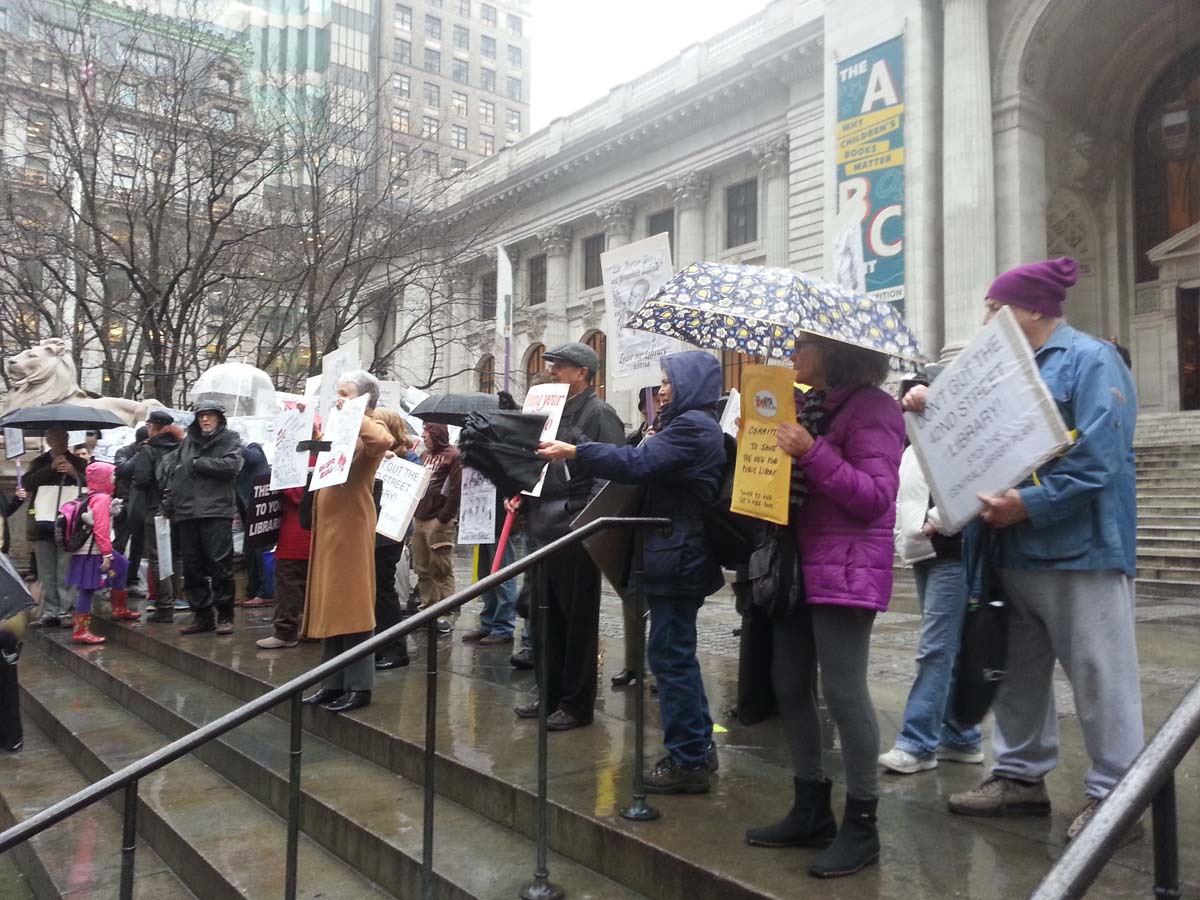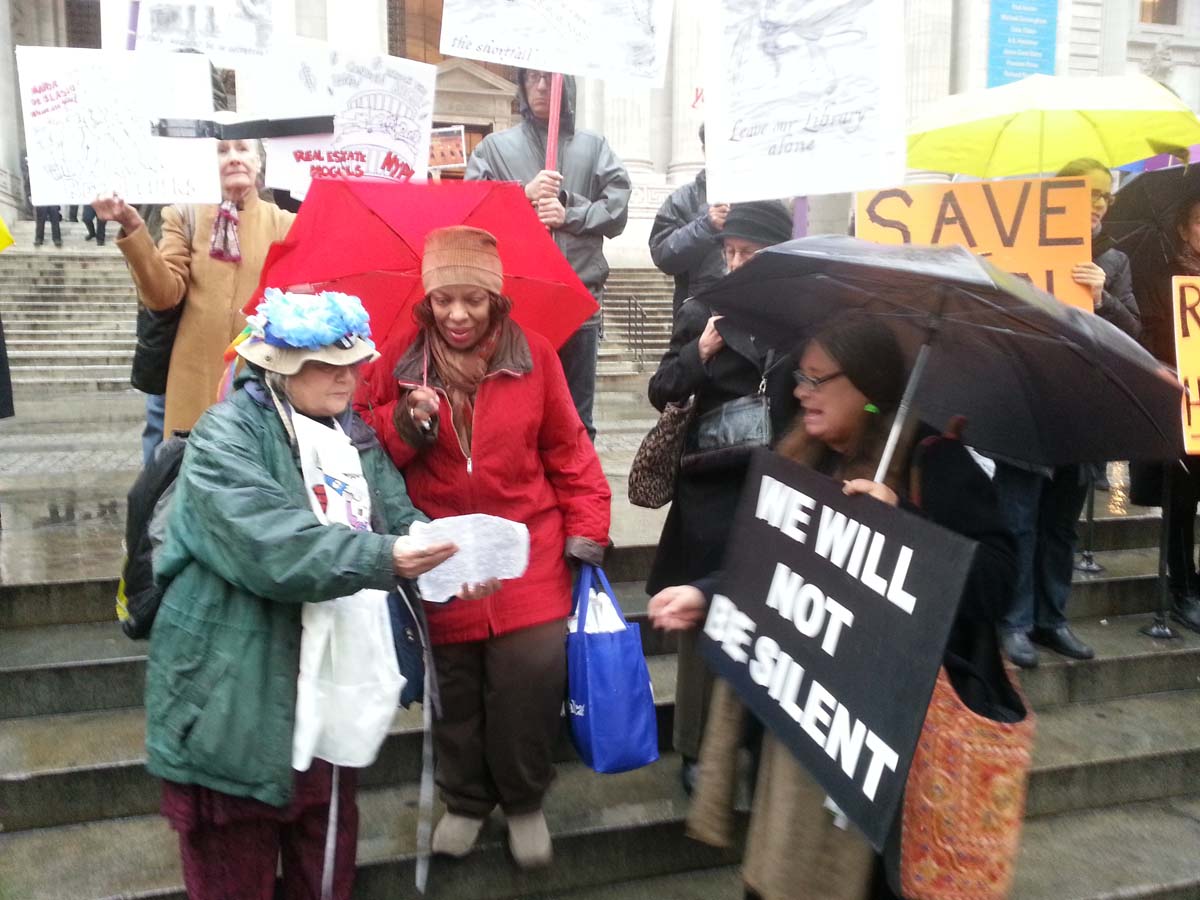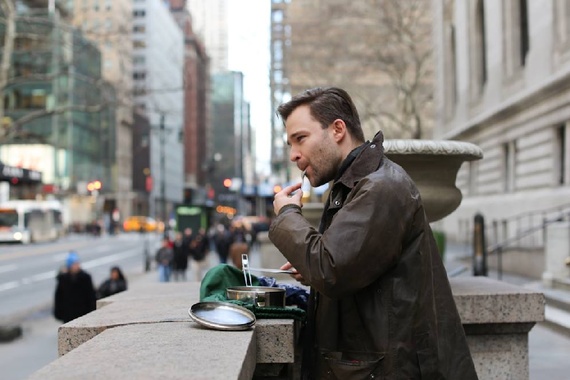
It was a Wednesday in mid-March: the presumed wane of a long and relentless winter that had caused many fine minds to crack. Two buildings had exploded four miles northeast in East Harlem. Two more buildings dedicated to the pursuit of knowledge — the very framework of the New York Public Library system — were threatened by a fiendish desire for greed.
Only a few hours after the New York Public Library stage-managed a few beatific rays of sunshine in the form of the belated Lotte Fields, who bequeathed $6 million to the NYPL simply because she loved to read, imposing gray clouds drifted over the stunning stone edifice of the New York Public Library’s main branch. The twin lions rested regal as raindrops pelted upon sixty brave souls, gathering in a steady drench to protest the Central Library Plan, a scheme to close and sell off two vital hubs of the system — the Science, Industry and Business Library (known as SIBL) and the Mid-Manhattan branch — for a wasteful consolidation of books into a overcrowded space that is estimated to cost more than $300 million.
Last July, Bill de Blasio — then Public Advocate, today the chronically tardy Mayor of New York — railed against the plan, lambasting the lack of “forethought to the building’s historical and cultural integrity.” But despite the vocal admonitions from the Committee to Save the New York Public Library — which gained prominent publicity a few weeks ago through a Humans of New York entry featuring a young man named Matthew Zadrozny eating chicken that went viral, the Mayor has remained steadfastly silent. His glaring inaction, together with continued meetings behind closed doors, has forced the Committee to amp up its efforts.
“The Board of Trustees of the New York Public Library is meeting today,” said Theodore Grunewald, a dapper man of the streets with horn-rimmed glasses, a bushy beard, and a three-piece purple windowpane suit. He identified himself as the Vice President for the Committee to Save the NYPL and was fond of standing next to a de Blasio cardboard cutout, a mildly unsettling likeness reminiscent of the flattened, life-size, B-grade stars that once advertised dicey action movies in video stores.
“One of the items on their agenda,” continued Grunewald, “is, no doubt, the $350 million+ costs of this project, which consists, by the way, of selling the Mid-Manhattan Library to real estate developers, then moving that facility into the Central Research Library. But in order to make room for it, they have to remove seven levels of book stacks underneath the Main Reading Room. Those books serve the Rose Reading Room. They make it possible for scholars and researchers to do their work. Their absence from this building and the banishment of 1.5 million volumes from the key research collections of the New York Public Library to off-site storage will decimate this research library as a research institution.”
Grunewald observed that the main branch, along with the Bibliothèque nationale de France and the British Library, was one of the three greatest research libraries in the world. But unlike the other two research libraries, the NYPL is open to anyone. You do not need to show your credentials to use the facility. In many ways, this open policy makes the main branch the ultimate public library.
“This is one of the most remarkable and innovative buildings in the world,” said Charles D. Warren, an architect and President of the Committee. “Not just because of its great exterior, but because inside its stone frame is a steel structure like a skyscraper building. That’s what holds up the books. Not only does it hold up the books, but it holds up the floor of the Rose Reading Room. And to take those out completely diminishes the meaning and the purpose of this building.”
Warren claimed that the main branch was not in need of serious renovation. “New air conditioning. New fire suppression. That’s it.”
Mass protests usually attract disparate activists. The hope is that a passion for one cause will inspire a protester to put time in another. One protester disseminated a “gift” bag featuring leaflets for an education project that had nothing whatsoever to do with the library.
But the Wednesday rally was mostly on point. It included Citizens Defending Libraries and the Library Lovers League. Representatives from each of these groups had attended Tuesday night’s city budget meeting on libraries.
I was fond of the Raging Grannies. Despite the insinuated belligerence, the Raging Grannies were a calm and lively group of women with an affinity for music.
“Sometimes we sing against the war,” said Raging Granny Judith Ackerman. “Sometimes we sing against fracking and nuclear reactors.”
But on Wednesday, the Raging Grannies came armed with a fistful of library songs, one of which can be heard below:
To play the media you will need to either update your browser to a recent version or update your Flash plugin.
There is also a small book published by the Committee — The Library of Libraries — which is being sold for $5 to help generate funds for the campaign. Publicists for the Save NYPL campaign were kind enough to provide me with a copy earlier this week. The book, described as “a parable,” is written and illustrated by Simon Verity. It contains many red hearts inserted among the prose and depicts vicious rhinos roaming the inner sanctum of the library with malicious intent. The book is an elaboration on Verity’s 2013 commentary, previously published at the Institute of Classical Architecture & Art’s blog.
All this represents the beginnings of a flourishing movement. But the more practical matter of getting an ostensibly progressive mayor to take time away from his hyperbolic Swedish programs to fulfill his pledge and avert the destruction of a major cultural part of New York remains a more grueling challenge. The Committee was a bit diffident on this point.
When I asked about the Committee’s efforts to contact de Blasio, Grunewald reported that the Committee was “working assiduously to reach out to him.” I asked if the Committee had heard anything from de Blasio’s office. Grunewald ignored this question, pointing to an online petition with 4,600 signatures. It was at this point that a mysterious gentleman named Jack, hearing my inquiries, suggested to Grunewald that “we should probably be getting these signs up.” I tried again as Grunewald excavated the many vivacious signs from the plastic wrap.
“Have you actually heard a single peep from him by email, by phone, or anything like that?”
“It is a concern,” said Grunewald. “We did reach out to the Community Affairs Office at City Hall. We’re waiting to hear back.”
But while the Mayor refuses to meet or return calls, the Committee has made efforts to cut through the high-paid lobbyists and consultants, finding some elected officials who are willing to talk. Committee President Charles Warren wouldn’t name anybody specific, but he seemed optimistic.
“We are trying to talk with any elected officials we possibly can,” said Warren. “We have had some very good meetings and we have some upcoming meetings with some of them. We would love to meet with the Mayor.”
Warren suggested that the Council and the Controller may be receptive to the Committee’s message. He also pointed to the State’s landmark authority over the main branch, which is still being litigated. It is still possible that the State could reject any attempt to modify the building’s structure. Warren noted that two court actions were holding up the Central Library Plan: one by a citizens group and one involving Weiss and Hiller (representing plaintiffs Edmund Morris, et al.).
Several protesters informed me that they would take the rally to City Hall if they had to. But what remains unclear is the timetable, the manner in which the Committee is organized, and whether these efforts have any bewitching effect beyond a popular photoblog.
It turned out that Matthew Zadrozny, the aforementioned pollo-eating beefcake, was at the rally. He went out of his way to approach me. He asked if I was a reporter. I told that him I was in a way. And we chatted.
To play the media you will need to either update your browser to a recent version or update your Flash plugin.
Correspondent: Who are you in relation to the Committee?
Zadrozny: I am working with the Committee. I’ve been with the Committee since December. I’ve been attending these protests since June of last year. And every Saturday, I’m organizing the weekly work-in protests at the library. We’re asking the public to come and protest while you work by sitting in the Main Reading Room, getting your work done with a www.savenypl.org sticker on your laptop.
Correspondent: I’ve seen those protests being announced. How much turnout? I mean, that seems more of a passive-aggressive form of protesting, I think.
Zadrozny: Well…
Correspondent: This is very active, however.
Zadrozny: Today’s protest is very active. On Saturdays, we want to garner the regular users of the library and give them ways to express their outrage at what’s happening by just getting their work done with a sticker.
Correspondent: Aha.
Zadrozny: It’s as simple as that.
Correspondent: It’s protesting for introverts.
Zadrozny: Protest…not necessarily. We encourage them to email the Mayor at savenypl.org. But we also encourage people to come out afterwards, get a drink with us, and talk about the future of the library.
Correspondent: Mayor de Blasio has remained silent. So are these protests doing any good?
Zadrozny: Mayor de Blasio, as Public Advocate, came out criticizing the plan. As Mayor, it’s true. He’s remained silent. We’re still waiting to hear from him. But we’re hopeful.
Correspondent: You’re hopeful. Why are you hopeful?
Zadrozny: We’re hopeful because he took a stand as Public Advocate and we believe that he understands the impact that this would have on the city and on local communities.
Correspondent: Is it possible though that the Committee was used in a political gesture rather than an actual act of true political movement?
Zadrozny: Uh…we don’t think so.
Correspondent: Why?
Zadrozny: Because we believe that the Mayor understands that this is, in many respects, an issue of equality, of opportunity. We believe the Mayor understands that if the Mid-Manhattan and the Science, Industry, and Business Libraries close, the amount of space in the system will be reduced. We believe that the Mayor understands that if Mid-Manhattan closes, there will be less space for students in the CUNY system to study. We believe that the Mayor understands that this is bad for New Yorkers.
Correspondent: Is it possible though that the Mayor has changed his mind?
Zadrozny: (pause) We’ll find out.
[May 7, 2014 UPDATE: The New York Public Library abandoned the Central Library Plan, opting to renovate the Mid-Manhattan Library on Fifth Avenue instead. The main library is no longer under threat.]



